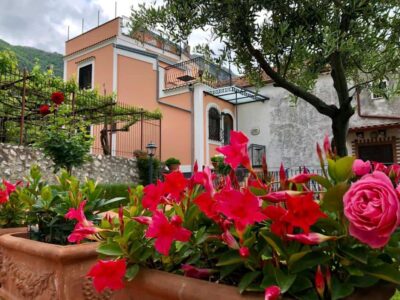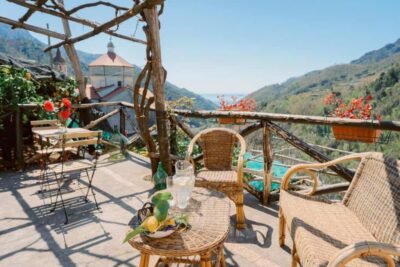Set among the beautiful valleys of the Lattari Mountains, stands a green village named Tramonti, or “intra montes,” land among the mountains.
Called £the lung of the Amalfi Coast”, Tramonti’s landscape is characterized by rich vegetation and numerous water springs.
An enchanted little village, spread among several hamlets, it offers an alternative setting to the typical seascape of the Amalfi Coast. The silence of the green and dense woods, combined with the sound of the streams running through the hills, makes Tramonti the ideal destination for those who love to immerse themselves in nature and get away from the city buzz.
Indice dei contenuti
How to get to Tramonti
Tramonti is located 65 km from Naples, and only 37 km from Salerno.
✅ By car: driving along the A3 Naples-Salerno highway, exit at the Angri or Nocera Inferiore tollbooth and continue to Amalfi Coast – Tramonti, crossing the picturesque Valico di Chiunzi. Otherwise, once you have arrived in Salerno, you can also reach your destination via State Road 163 Amalfitana, which, taking it from Vietri, will take you as far as Maiori, where you will turn at the Maiori-Chiunzi junction, continuing to Tramonti, which is only 8 km from Maiori.
✅ By train: the nearest train station is Nocera Inferiore, on the Salerno-Naples line, from where you can then continue by bus with one of the SITA SUD bus lines. Alternatively, refer to the Salerno station and reach Maiori by sita buses (Salerno – Amalfi line). From Maiori continue with another aubobus bound for Tramonti.
Alternatively, from Molo Concordia you can travel aboard Travelmar Ferries to Maiori.
📣 Your road free from queues: book the ferry!
Similarly, also from Salerno, or from the other towns on the Amalfi Coast, there are several SITA bus lines connecting Tramonti to the remaining towns on the Amalfi Coast.
If you’re looking for more information about getting around the Amalfi Coast, we’ve prepared a free guide for you, with lots of tips for comfortable and stress-free travel, whether by car or public transportation!
Where to Sleep in Tramonti
📣 The Amalfi Coast is waiting for you!
Book now among the best accommodations selected for you!
What to see in Tramonti
A community spread among several hamlets scattered among the wooded hills: this is how this green locality appears, inviting pleasant walks among small hamlets, discovering ancient churches, traditions sheltered from the passing of time, and decidedly bucolic rhythms of life.
The thirteen hamlets of Tramonti are oases of peace, far from the mundanity of nearby Maiori: small autonomous communities, each with its own church and square, connected by a series of small streets and paths, just waiting to be walked, to give the forgotten pleasure of silent walks, in the shade of chestnut groves, tramping through bushes of hawthorn and elder.
A place to be seen, but above all to be felt in all its manifestations: from the time that flows slowly and sweetly to the peasants who follow with ancient wisdom the rhythm of nature and the passing of the seasons, from the sounds and scents of nature to the flavors of a cuisine that makes simplicity and authenticity its boast, a visit to Tramonti gives the unique pleasure of a journey on the paths of authenticity.
The thirteen hamlets that make up the community of Tramonti are:
📍 Pucara, formerly known as Pocara, where the church of S. Erasmo and the Royal Monastery of S. Giuseppe and Santa Teresa are located. The latter, once a conservatory that took in girls, youths and foundlings, was transformed into a monastery on December 8, 1723, by Venerable Mother Serafina.
📍 Novella, a small village where an old parish church, now dedicated to St. Bartholomew, was once named after St. Anthony because it belonged to the confraternity of the same name.
📍 Gete, named after a local patrician family, De Getis, has its own parish church dedicated to St. Michael the Archangel, and a splendid 13th-century rock chapel.
📍 Ponte, a hamlet of modest size, both in size and in number of inhabitants. It has a parish church dedicated to St. Felice, but Our Lady of the Rosary, commonly called Madonna del Ponte, is also much venerated.
📍 Campinola, deriving from Campi di Nola, that is, the seat of a group of Nolan soldiers anciently present on the site. It is the largest hamlet in Tramonti with a parish church dedicated to Our Lady of Mount Carmel with the Confraternity of the Holy Name of God attached.
📍 Corsano, the ancient Cupersanum, with a parish church dedicated to St. Peter the Apostle.
📍 Cesarano, named after Caesar because of the Roman imprint of its foundation, has a large three-nave parish church dedicated to the Assumption, in which the precious relic of the arm of St. Tryphon, found during the 1514 expansion work, is kept.
📍 Pietre, named after the rocky nature of the place, has the parish church dedicated to S. Felice di Tenna, but the Madonna delle Grazie whose feast with procession takes place on July 2 is also highly revered.
📍 Capitignano, from the name of a local patrician family the Capistrano; has its 16th-century parish church dedicated to St. Mary of the Snow, originally dedicated to St. James the Apostle.
📍 Figlino, from figlini: the newborn illegitimate children taken in at the brefotrophy present on the site, now placed under the present church dedicated to SS. Annunziata, patroness of nobody’s children.Of particular importance is the church of S. Pietro, which has an entirely decorated Baroque-style structure inside.
📍 Paterno S. Arcangelo, located on the slopes of Montalto on which stood the castle of the same name, preserves a church dedicated to the Assumption, in Romanesque style and dating from the 9th-10th centuries. Recently renovated and enhanced after the collapse of the parish church of St. Michael, destroyed in the Nov. 23, 1980 earthquake.
📍 Paterno St. Elias, formerly called St. Elias of Satrone, with a parish church dedicated to St. Elias; devotion to Our Lady of Mercy, whose feast day is celebrated on Sept. 8 each year, is very much felt.
📍 Polvica: seat of the administrative center of Tramonti. The hamlet houses a Franciscan convent founded in 1474 with an adjoining church, in which it is possible to observe the marble tombs of two distinguished prelates originally from Tramonti: Ambrogio Romano, bishop of Minori, and Martino de Maio, bishop of Bisceglie.
📣 Below are the places of historical and cultural interest that you really cannot miss in Tramonti:
✅ The Secret Garden of the Soul: This beautiful garden is located in Campinola and is a little secret Eden, cultivated and cared for with love by the owners. The path winds through 8 terraces that have been expertly recovered from an old abandoned vineyard. The area is divided into 25 sectors, including a citrus grove with various species, a rose garden with 300 species, aromatic and medicinal plants, hydrangeas and flowers.
A wonderful project where the passion for the area and the desire for botanical experimentation meet, resulting in this experimental ecomuseum, which gives unique emotions.
✅ Rock Chapel of St. Michael the Archangel: stands next to the remains of the Church of St. Angelo. According to scholars, it dates back to the period between the 8th and 12th centuries; according to others, it dates back to the 5th century, the period of settlement of the first Christian ascetics from the Balkan regions. The chapel has two naves, while the arches follow the natural course of the rock. Inside, a frescoed necropolis of probably pagan times is visible. The place is imbued with charm as it is immersed in nature, enveloped in a silence that invites meditation and contemplation. The remains of the Church of St. Mark, destroyed by a cataclysm in the 1700s, are visible in the adjacent area.
✅ The Conservatory of St. Joseph and St. Teresa: It is located in Pucara and, according to tradition, is the place where Concerto, a delicious liquor of the Amalfi Coast, is said to have been born. The Conservatory began operating as an educational boarding school for noble girls starting in 1662 by testamentary provision of Francesco Antonio Ricca. The institution played a leading role, not only in religious matters, but also in political and lineage matters.
✅ The Church of Saint Elias: located in the hamlet of Paterno. In this Church you can admire the portal carved in lava stone and an ancient baptismal font dating back to 1458.
✅ Also worth visiting is the Church of St. Peter the Apostle, in the hamlet of Figlino.
What to do in Tramonti
📣 We have selected the best experiences in and around Maiori!
Trekking and walking
Walking along paths and mule tracks that connect all the hamlets of Tramonti will allow you to observe the particular conformation of this place, where each hamlet seems to gather around its own church. You will walk among vegetable gardens, lemon terraces and centuries-old vineyards. You will observe vines climbing up to chestnut groves, also centuries old. In short, you will walk along paths that become gateways to past eras and allow you to savor the authenticity of secluded, silent, almost sacred places.
📍 The path of the 13 churches
Through this path, which starts from the church of Sant’Erasmo in the hamlet of Pucara and winds its way through the 13 hamlets of Tramonti, arriving at Novella, you cross the entire town, among verdant lemon groves, churches, squares and lush vineyards of tintore grapes, a native and unique variety.
The route covers a length of about 15 km: it is a circular route that can be walked from any hamlet of Tramonti, but conventionally you start from the hamlet of Pucara. You can also opt for a shorter version of the route, cutting through the hamlet of Polvica: in this case, you will not go through all the hamlets, but about half. Along the way you will find numerous fountains, to hydrate and refresh yourself.
📍 From Tramonti to Maiori via the “Furmechelle” path.
The path just mentioned intersects in Paterno Sant’Elia with the “Furmechelle” road, named after the women who carried on their backs the heavy baskets of lemons, the yellow jewel of the Amalfi Coast. The topic is extremely interesting, as it encapsulates the essence of the Costiera soul: if you want to go deeper, we recommend our detailed article where we tell the story of our sfusato amalfitano.
The route is of medium difficulty, with a total length of about 6.5 km. It reaches the Collegiate Church of Santa Maria a Mare in Maiori.
📍 The “Via de La Cava”
Definitely challenging, this route leads to Cava dei Tirreni, Monte Finestra and the Badia. It starts from Chiancolella and Torina di Gete, taking the mule tracks that pass by the Fontanelle and Ricciariello springs.
Experiences you can only do in Tramonti
Among the experiences to do in Tramonti, after the long walks through villages, it is impossible not to recommend tasting the typical products and dishes made from the combination of these precious raw materials.
From the rich vegetation of the territory of Tramonti, in fact, come delicious typical products, unique for their quality and genuineness, expertly processed and packaged by local artisan productions. Among the delicacies to be tasted in Tramonti, we recommend: fior di latte, chestnut honey, Extra Virgin Olive Oil, wine, craft beer and, above all, Pizza De.Co.
Tramonti has the distinction of having made pizza known all over the world, thanks to the skill of Tramonti’s master pizza makers who, from the postwar period onward, left the Amalfi Coast to emigrate to rich Northern Italy, importing this delicious product from Campania. If you are a gourmet traveler and would like to learn more about this topic, we invite you to read our article dedicated to Pizza di Tramonti.
We also recommend that you go on a journey to discover the unique local wines. The climate of Tramonti, in fact, has given birth to flourishing vineyards from which fine wines have been born, which today have become famous and exported throughout Italy. You can discover more by reading our article dedicated to the wines of the Amalfi Coast.
In addition to tasting the area’s delicacies at the many agriturismi, trattorias and wineries in the area, we also recommend experiences of more intimate contact with the local culture and traditions, such as a visit to a centuries-old vineyard or lemon grove, a cooking class dedicated to Tramonti’s pizza or homemade pasta.
📣 Looking for inspiration to experience unique emotions in and around Tramonti?
Find the best experiences in the area selected for you here!
Events in Tramonti
A land of festivals under the banner of gourmet and conviviality, during the summer period the community of Tramonti organizes many events that lovers of folklore and good food really cannot miss.
✅ Historical procession of Tramonti, in July, at the hamlet of Polvica: a re-enactment of the events of 1460, when King Ferrante of Aragon, following the defeat of the Battle of Sarno, found refuge at the houses of the townspeople. Traditionally, the 13 teams, represented by groups from the 13 hamlets, compete for the palio by challenging each other at tug-of-war. There is no shortage of historical re-enactment, costume parade and tasting moments based on local delicacies.
✅ There are numerous patronal festivals, dedicated to the saints of the individual hamlets. Among the most important is that of the hamlet Polvica, dedicated to St. Francis, in October.
Why choose Tramonti as a destination
This more secret and secluded location invites to tranquility and calm, away from the crowds and chaos. If the sea is really a must for you and during your vacation your priority is to take a place on the beach, we do not recommend choosing Tramonti as the base of your vacation, as it would be inconvenient to move several times a day to reach nearby Maiori. In any case, if you choose to stay overnight in Tramonti, an independent means of transportation would be preferable to bus travel.
📣 We recommend that you choose Tramonti as your Amalfi Coast trip destination if:
🔹You are looking for a more secluded place where you can unplug and enjoy some healthy idleness, in silence and in contact with nature;
🔹 you love places that have remained unspoiled and unchanged by the passage of time. Here you will be in contact with traditions that the people of Tramonti have jealously preserved.
🔹 If you want to keep your accommodation expenses in check, you will find lower average prices here than in other towns on the Amalfi Coast.
The best time to visit Tramonti
We recommend visiting Tramonti during the spring or during the fall, especially in September and October. In these months, in fact, you will find the ideal climate to enjoy walks through villages and you will avoid the risk of traffic and traffic jams along the State Road 163 Amalfitana, which in the months from June to September and especially on weekends, is taken by assault by travelers and tourists. Even early winter weekends, if one is lucky enough to spot sunny days, can provide great satisfaction.
Interesting facts about Tramonti
✅ On November 1, the day dedicated to the commemoration of the dead, the tradition of eating pizza for lunch is observed in Tramonti. In the past, families would walk to cemeteries, which took several hours, making lunch preparation difficult for housewives. Thus, the custom of consuming pizzas on the way back spread, usually topped with tomato, oregano, oil and a few anchovies. This tradition is still alive both in Tramonti and in other towns along the Amalfi Coast.
History of Tramonti
According to historian Filippo Cerasuoli, Tramonti was founded by the Picentines of the Osco-Umbro group, mixed with Etruscans and other peoples who, around 200 B.C., defeated by the Romans, found refuge in the valley, building the first hamlets there; as evidenced by numerous archaeological finds. Closely linked to the town of Amalfi, Tramonti was of great importance in the birth of the Amalfi Republic.
It was involved, along with the coastal populations, in the defense of the city against the Lombards, until Amalfi was proclaimed a Republic in 839. It began from then on the period of maximum splendor that lasted for more than two centuries, both in the economic-commercial and cultural fields.
Many noble families of Tramonti thus became part of the Amalfi and Ravello aristocracy. To them belonged distinguished men in the economic, legal and administrative fields, advisors to Princes and Kings. This explains how Tramonti, today, has a large number of ancient churches scattered over its territory and is rich in monuments from various eras.
In the assault that the Normans, under the command of Ruggiero the Norman, made against the Republic of Amalfi, Tramonti strongly opposed the enemy forces with the garrison of the fortress of Montalto.
This fortress being overpowered, the castle of Ravello also fell and thus occurred the final surrender of the Amalfi Republic, which in 1127 was subjugated to Norman rule.
Thus began the dark period of Amalfi, and the grandeur and Importance of Tramonti and the other coastal towns also declined. From the Normans, the Duchy of Amalfi passed to the Swabians in 1197, then to the Angevins in 1266 and then to the Aragonese in 1442.







